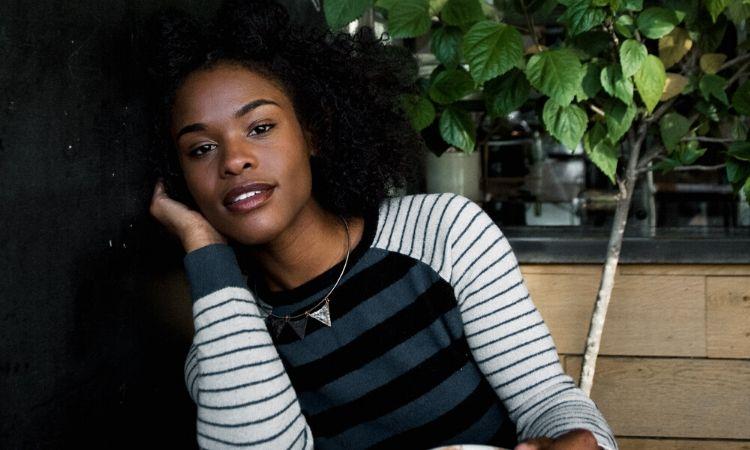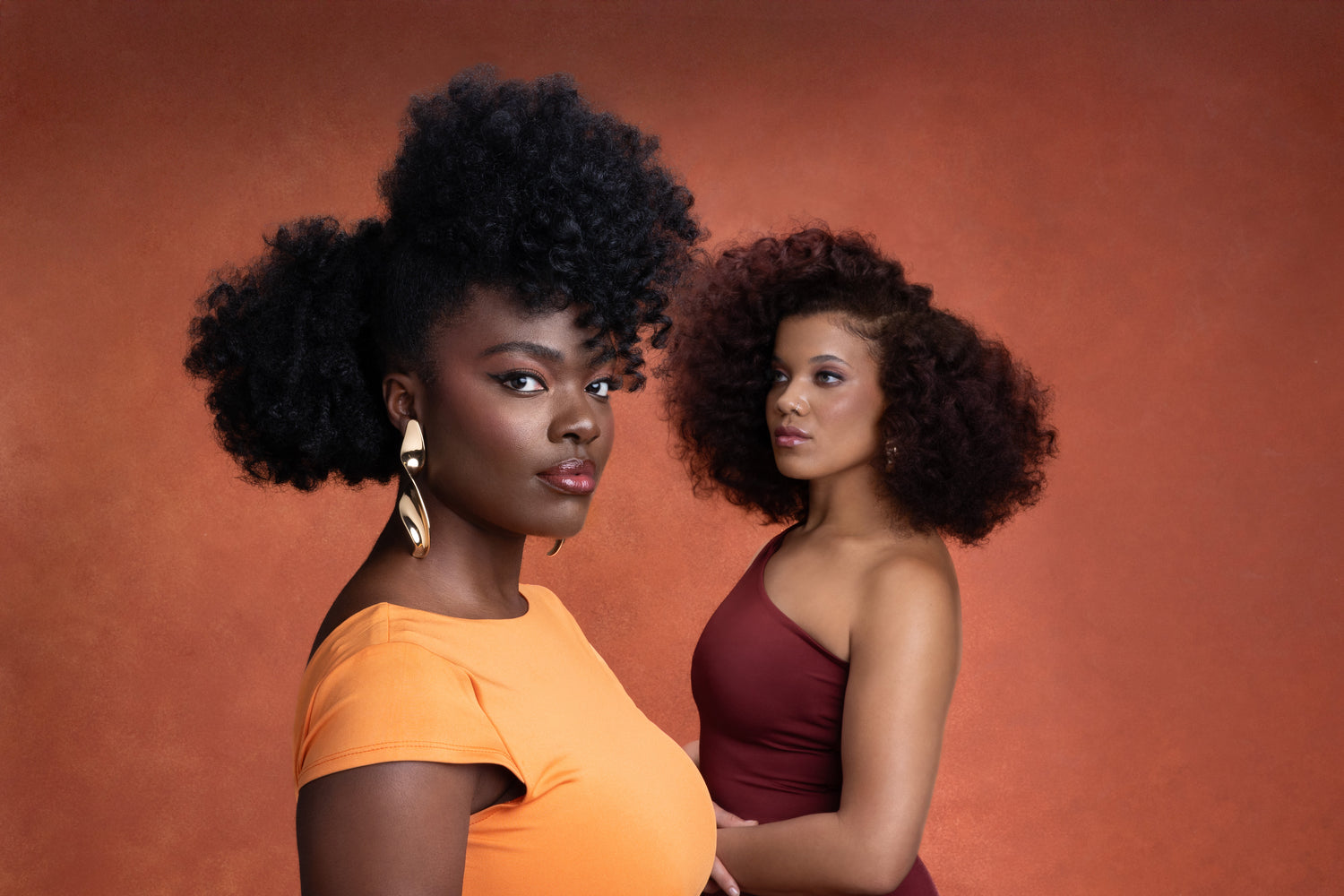Wondering what "transitioning" means or how to do it? There's a lot of hair jargon out there. Transitioning to natural hair is the process that involves no longer using a hair relaxer, letting your natural hair texture grow and gradually cutting off the chemically processed or damaged ends.
Want to transition to natural hair but not sure where to start? Or has lockdown caused you to ‘forcibly’ transition? Whatever your reasons for going from relaxed to natural, our transitioning to natural hair guide will give you all the tips and guidance you need to make the natural hair transition easier.
1. Handle Your Transitioning Natural Hair With Care
During your transition, it's important to handle your hair with extreme care as it is very fragile — especially at the point where the natural and relaxed parts meet.
Before handling your hair, pause and look at your hands. You don’t want your hair to get snagged and damaged. So, it’s important to remove your rings and also inspect your nails – are they chipped or are they broken?

Also, ditch that fine tooth comb and broken bobby pins! We want to avoid damaging our hair at all costs and these combs and poor accessories can easily cause breakage.
We recommend using your fingers to comb or detangle your hair. And have a look at your accessories – get rid of hairbands and ties with metal and plastic fastenings. Don’t use hair pins without the coated tips as these can snag and also cause damage.
And please, please, please make sure that you’re sleeping with a protective bonnet/scarf or pillowcase.
Most pillowcases are made of cotton. Cotton is super absorbent, meaning those fibres basically rob you of all the moisture that you’ve been working on locking into your hair. So, upgrade your night routine and trade your cotton pillowcase for a satin or silk one. Or if you don’t want to mess up your bedroom decor, just wear a satin or silk bonnet or headscarf. This will help you retain moisture and reduce friction on your hair.
2. Use Quality Hair Products (Avoid Toxic or Drying Ingredients!)
As we mentioned earlier, up to 60% of what we put into our body is absorbed into our bloodstream. That is a staggering percentage, yet often, little care goes into the ingredients used in most cosmetics – especially cosmetics marketed to black women. Natural products are safer to use and can often be more effective when it comes to maintaining natural hair healthy.

Our products are thoughtfully formulated with health and hair hydration in mind. Silicones, parabens, sulphates and artificial fragrances can cause irritation, so we don't use them.
You'll find only the best natural ingredients in all our products and The Newly Natural Set is a great place to start if you’ve just cut off relaxed ends.
3. Learn About Transitioning Hair Care & How To Look After Your ‘New’ Hair Texture
The main reason that people relax their hair is that they are led to believe that maintaining relaxed hair is faster and easier. There‘s a misconception that it takes hours and hours to get natural hair to "do what you want it to do."
In reality, the myth that learning how to look after Afro hair and properly maintain it requires a significantly greater amount of time is simply not true.
Finding out what makes your hair thrive before you apply any product is essential to seeing the progress of your hair. Working with your hair’s natural form while also managing your relaxed hair can be tricky but if you use good quality products in your routine, your hair will not only be manageable but it will look great too.
4. Create a Simple Wash Day Routine
Many people delay going natural because they hear stories of it taking a full day (i.e. the term ‘wash day’) to wash and condition their hair. But that's not necessary! A full treatment often looks like this:
- Pre-poo treatment (deep conditioning before shampoo, often done with an oil like Soothe)
- Shampooing (hopefully with a sulphate-free shampoo)
- Post-shampoo conditioner
- Protecting and moisturising (either with oils or oil-based products)
- Drying and styling
Doing all of these in one day may sound like a lot, but it doesn’t need to be this way. Many people simplify their routine by breaking down this list into smaller, more manageable hair care tasks. Others do so by using great products that help to speed up the process.
For example, you can shampoo and condition once every 7-10 days. Conditioning is an effective way of softening, moisturising and drying your hair shaft quicker.
Conditioners, similar to oils, prevent water from escaping from both the inside and outside of the hair shaft. Specifically, they create polar barrier that prevents the penetrated water from leaving the hair shaft while avoiding the water that is on the hair. Using oils creates a similar barrier but without any charge, meaning that they are less irritant to both your hair and skin. For this reason, oils are good to use before, after and during drying or styling.
Introducing natural but powerful oils to your routine can help you to break down the wash day routine into smaller parts. It can also keep your natural Afro hair healthy, which will make it easier to manage over time.
5. Avoid Heat
Choosing a microfibre towel instead of a regular cotton towel is a much healthier option for your hair as it can absorb the excess water much more easily. The microfibre towel also reduces the strain and friction during blot drying and therefore reduces the chances of hair frizz, breakage and thinning.
Avoid blow drying your hair as it can damage your hair. Drying without heat is easier and leaves hair softer and stronger in the long run.
6. Keep Your Hair Moisturised
Simply put, dry hair breaks easily and your afro hair as well as your relaxed hair are prone to dryness, so it’s important to protect your hair by locking in moisture.
So how do you lock in moisture? We recommend layering on products in what is known as the the LCO/LOC method:
L - Apply a Liquid.
A water based moisturising product in the form of a spray is best. We recommend Sheen, a water based blend of aloe vera juice, grape seed oil and essential oils. The hair is made of protein bundles kept together by hydrogen bonds and disulphide bonds. To keep hair strong it's important to keep it full of the moisture it needs for the hydrogen bonds and the most effective moisturiser is water!
O - Seal in the moisture with an Oil.
Water evaporates easily from the hair so a relatively thick oil blend is needed to seal in moisture. The best blends contain olive oil, coconut oil, castor oil and jojoba oil. Seal contains all of these and more so it's our top recommendation, it was recently voted the Indy Best top oil for afro hair because it: "penetrates the hair shaft and leaves your strands feeling hydrated and super soft, and it remains that way for hours afterwards."
C - Layer on a Cream.
This should be a water based moisturiser but not as fluid as the product used in the liquid step. A moisturising cream or leave-in conditioner will do the trick. We recommend Smooth, with its blend of coconut oil, olive extract and organic & fairtrade shea butter.
7. Use Protective Styles
Moving from straight hair to textured tresses can be a shock to the system. As such, protective styling with a wig or braided/twisted extensions that match your newly-sprung natural hair texture is a great way to get used to your natural hair.
Care for your hair underneath with our Protective Style Set or our Under The Wig Set. Also, during this time, be sure to avoid heat; Bantu knot-outs and flexi rod sets are great for blending the two textures.
8. Get Regular Trims
The relaxed hair is often porous and fragile, making it more susceptible to split ends. Keep on top of trimming the ends of your relaxed hair to prevent spilt ends travelling up your hair and causing more damage.
9. Consider The Big Chop
Don’t want to deal with two different hair textures? Then you might want to consider the big chop. The big chop involves cutting off all relaxed/heat damaged hair off and leaving only your new growth, which is natural hair.
This effectively takes your natural hair journey from transitioning to officially 100% natural in a matter of minutes. The big chop isn’t for everyone but if you decide to go for it you will be starting with a TWA (teeny weeny afro), so be playful and accessorise with earrings, hair bands or opt for getting your afro shaped.
10. Keep a Hair Diary
It’s useful to keep note of things that worked well, things that could have gone better and notes on what you’ve been learning and experimenting with. It’s a great way to keep track of everything and also, you can look back and see how far you’ve come! It doesn’t have to be a physical notebook, it could be in a digital format or even in notes on your phone. Photos are also a great way to document your progress.
11. Don’t Give Up!
The awkward phase is the time when most people give up on their natural hair journey. Times may be difficult but through perseverance, you can make it to the other side! It's important to remember that it's just a phase and it won't last. Stay strong and check our tips on how to not give up on your hair during the awkward phase.
12. Find a Natural Hair Community
As you grow your hair out be sure to enjoy every stage. It’s exciting to learn, experiment and explore your ‘new’ hair texture. Get support from friends and family and join a virtual community – you can always connect with the Afrocenchix team on any of our social platforms or via email.
More Articles:
Jacqueline's Hair Story — Why She Went Natural

